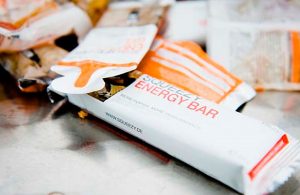Nothing works without energy
 When the tank of our car is empty, we are not surprised that we break down. This conclusion can also be applied to the human organism. Before we take a closer look at this, however, it makes sense to first get to know the primary sources of energy under stress. For the athlete, two are particularly important:
When the tank of our car is empty, we are not surprised that we break down. This conclusion can also be applied to the human organism. Before we take a closer look at this, however, it makes sense to first get to know the primary sources of energy under stress. For the athlete, two are particularly important:
Fat - fat produced naturally in the body
Glycogen - storage form of carbohydrates contained in muscles and liver.
Let's start with the body's own fat. Two important premises are interesting here.
1. energy production from the body's own fat is slow for our organism. This leads to the fact that with increasing intensity in sports, the relative fat share of energy production becomes smaller and smaller.
2. there is a nice bridge of thought here: "the fats burn in the flame of carbohydrates". What is meant by this is that effective fat burning also requires a certain amount of carbohydrates. Theoretically, our body has enough fat reserves for energy production to ride almost the entire Tour de France (approx. 300,000 Kcal), but in doing so we need carbohydrates on the one hand and on the other hand we must not then ride too fast, which is not really fun.
This brings us to the essential source of energy for the endurance athlete: the glycogen store and thus the carbohydrates.
Here I would like to start with a comparison: What good is the best sports car if I can only get 200km on a tank of gas in everyday life? This or something similar is also the case with our glycogen stores. Glycogen is stored in our human body only in the muscles and in the liver - about 1600 Kcal.
The most important thing to remember is that even when glycogen stores are 100% full, the energy will only last for a maximum of 120 minutes at high intensity.
Fortunately, we don't have to go to the gas station, but can supply the carbohydrates we need to replenish our glycogen stores through energy gels, energy bars or drinks even during exercise.
If we now add two more important factors, namely:
1. our brain normally uses only glucose as energy (important for concentration and motor function)
2. a very strong decrease of the glycogen stores or an empty store impairs and worsens the recovery phase and the immune system results consequently:
On the one hand, the glycogen stores should be sufficiently filled before intense and long loads (carboloading / pasta party) and on the other hand, it is important to also consume carbohydrates during intense endurance exercise, at least if it lasts longer than one hour.
We now come to the question of which carbohydrates, because carbohydrate is by no means equal to carbohydrate.
Just as there is gasoline, premium gasoline, or even kerosene, there is also the energy carrier that is important for us - carbohydrates. Chemically, a distinction is made primarily between monosaccharides, di-saccharides and polysaccharides.
What should this tell us?
Quite simply - monosaccharides are simple sugar molecules, such as simple glucose or fructose. A disaccharide is, for example, our ordinary household sugar.
They enter the bloodstream very quickly, thus increasing blood sugar and are metabolized accordingly quickly as an energy source. Now you might think that this alone makes them optimal for athletes, especially endurance athletes. This is not the case.
This is because mono- and disaccharides not only quickly increase blood sugar, they also ensure that our pancreas releases a lot of insulin in a short time. The hormone insulin serves as a "cell opener" for the glucose. With the high insulin level, the blood sugar is quickly lowered again, but unfortunately usually below the normal range, so that hypoglycemia and thus a sharp drop in performance is the result. Unless, of course, a certain amount of sugar were to be ingested again very quickly.
Today, oligosaccharides, mostly maltodextrin, are increasingly used in sports nutrition products for endurance athletes. These are medium- to longer-chain carbohydrates that are metabolized more slowly and also do not cause blood sugar to rise as quickly and sharply.
| ! |
Especially for endurance athletes, it is therefore recommended to pay attention to a healthy mixture of carbohydrates, whereby the majority should always consist of the medium- and longer-chain carbohydrate polymers. This minimizes the risk of hypoglycemia. A small proportion of monosaccharides, in this case mostly glucose (= dextrose), provides a quick energy boost. |
You are welcome to download this article from the series "Das muss mal gesagt werden" as a download as PDF.
![]() You can find more statements of this series on this overview page ...
You can find more statements of this series on this overview page ...
